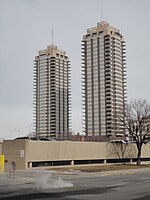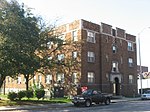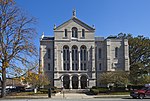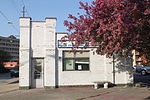The Dartmouth (Indianapolis, Indiana)
Apartment buildings in IndianaIndianapolis stubsMarion County, Indiana Registered Historic Place stubsNational Register of Historic Places in IndianapolisResidential buildings completed in 1930 ... and 2 more
Residential buildings in IndianapolisResidential buildings on the National Register of Historic Places in Indiana

The Dartmouth is a historic apartment building in Indianapolis, Indiana. It was built in 1890 and is a large six-story, nine-bay-by-twelve-bay building faced in two shades of center-scored, salt-glazed brown brick. It features two three-sided projecting bays, limestone accents, and a crenelated parapet.: Part 3, p. 5–6 It was listed on the National Register of Historic Places in 1983.
Excerpt from the Wikipedia article The Dartmouth (Indianapolis, Indiana) (License: CC BY-SA 3.0, Authors, Images).The Dartmouth (Indianapolis, Indiana)
Hudson Street, Indianapolis
Geographical coordinates (GPS) Address Nearby Places Show on map
Geographical coordinates (GPS)
| Latitude | Longitude |
|---|---|
| N 39.774722222222 ° | E -86.153333333333 ° |
Address
Hudson Street
46204 Indianapolis
Indiana, United States
Open on Google Maps









